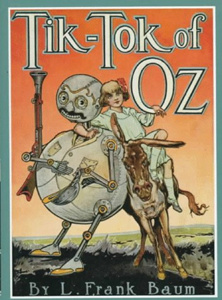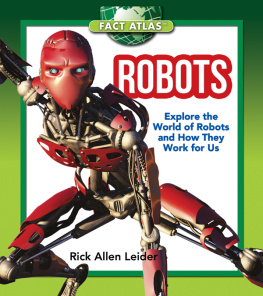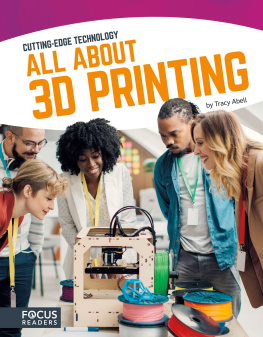
ROBOTS
CUTTING-EDGE TECHNOLOGY
by Lisa J. Amstutz
ALL ABOUT
ROBOTS
by Lisa J. Amstutz

www.northstareditions.com
Copyright 2017 by North Star Editions, Lake Elmo, MN 55042. All rights reserved. No
part of this book may be reproduced or utilized in any form or by any means without written
permission from the publisher.
Produced for North Star Editions by Red Line Editorial.
Photographs : Alex Gallardo/AP Images, cover, 1; NorGal/Shutterstock Images, 45;
Lightspring/Shutterstock Images, 7; Featureflash Photo Agency/Shutterstock Images, 9;
Nataliya Hora/Shutterstock Images, 1011; bibiphoto/Shutterstock Images, 13; Navin Mistry/
Shutterstock Images, 1415; NASA, 17, 27; hans engbers/Shutterstock Images, 1819; NASA/
JPL-Caltech/Malin Space Science Systems, 21; Master Video/Shutterstock Images, 23; Peter
Cihelka/The Free Lance-Star/AP Images, 2425; Steve Lagreca/Shutterstock Images, 2829
Content Consultant: Dr. Stelian Coros, Assistant Professor, Robotics Institute, Carnegie
MellonUniversity
ISBN
978-1-63517-014-6 (hardcover)
978-1-63517-070-2 (paperback)
978-1-63517-175-4 (ebook pdf)
978-1-63517-125-9 (hosted ebook)
Library of Congress Control Number: 2016949755
Printed in the United States of America
Mankato, MN
November, 2016
ABOUT THE AUTHOR
Lisa J. Amstutz is the author of more than 50 nonfiction books for children. She specializes
in topics related to science, nature, and agriculture. Lisas work has also appeared in a
variety of magazines and newspapers. Her background includes a BA in biology and an MS in
environmental science.
978-1-68444-293-5 (e-book)
Synched Read-Along Version by:
Triangle Interactive LLC
PO Box 573
Prior Lake, MN 55372

TABLE OF CONTENTS
CHAPTER 1
What Is a Robot?
CHAPTER 2
Are Robots Good or Bad?
CHAPTER 3
What Makes a Robot Tick?
CHAPTER 4
Robots Everywhere!
CHAPTER 5
Robots of the Future
HOW IT WORKS
Driverless Cars

CHAPTER
WHAT IS A ROBOT?
The first robotic vacuum cleaners became
available in the 1990s.
I
magine waking up in the morning to find
your breakfast already cooked and the
table set by a robot. While you eat, robots
do your laundry and vacuum the floor.
Then you hop into your self-driving car
and head to school. There, a robot teacher
helps you with your math.
Believe it or not, all of these robots
already exist! Some of them are not yet
widely available. But they will likely be
more common in the future.
Robots are machines that are used to
do tasks. The study of robots is called
robotics. The scientists who make robots
are called roboticists.
Robots come in many shapes and sizes.
Most are made of metal and plastic.
They have movable parts and follow
commands. Some can sense things
around them. Robots usually have at least
one arm. Some robots are microscopic.
Scientists are testing nanobots that
are small enough to go inside the body.

In the future, nanobots may be the size of cells.
These tiny robots can find problems and
fix them.
People have been building robot-like
machines for thousands of years. Around
BCE, a Greek named Archytas of
Tarentum created the first automaton,
or machine that could move by itself.
Archytass wooden bird could fly
hundreds of feet into the air.

In the early 1500s, Leonardo da Vinci
created a mechanical lion that could walk.
It was not until 1961 that robots came
into everyday use. That year, General
MEET ASIMO
ASIMO is a humanoid robot created by Honda. At
ASIMO may do tasks such as getting snacks and
turning off lights for people who are elderly or
disabled. It may even help fight fires or clean up
toxic spills.
Motors started using a robotic arm to

help build cars in its factories. Today,
robots are used for a wide variety of
tasks, including vacuuming floors and
defusing bombs. Scientists keep thinking
up new kinds of robots to help us with
hard, dirty, dangerous, and boring jobs.
Honda first introduced ASIMO in 2000.

CHAPTER
ARE ROBOTS
GOOD OR BAD?
W
hy do we need robots? Why not
let humans do all the work? Unlike
humans, robots do not get worn out when
they do dull jobs. Robots can often work
faster than humans and with fewer errors.
They can do difficult jobs, such as lifting
heavy car parts on a factory floor.
Today, car companies use many different types of
robots to produce vehicles.
They can also do dirty jobs, such as
checking sewage pipes for clogs.
Robots can do dangerous jobs as well.
Specialized robots can climb down into
a volcano to study it. They can search
through rubble for survivors after an
earthquake.
Robots help us in many ways. But they
can also have downsides. For example,
some people may lose their jobs when
a factory starts using robots instead
of human workers. Also, drones may
interfere with airplane flight paths.
























